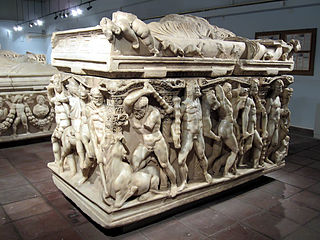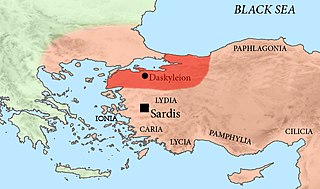Ipsus or Ipsos or Ipsous (Ἴψους), was a town of ancient Phrygia a few miles below Synnada. The place itself never was of any particular note, but it is celebrated in history for the great battle fought in its plains, in 301 BCE, by the aged Antigonus and his son Demetrius against the combined forces of Cassander, Lysimachus, and Seleucus, in which Antigonus lost his conquests and his life. From Hierocles and the Acts of Councils, we learn that in the seventh and eighth centuries it was the see of a Christian bishop. No longer the seat of a residential bishop, Ipsus remains a titular see of the Roman Catholic Church.

The Sakarya is the third longest river in Turkey. It runs through what in ancient times was known as Phrygia. It was considered one of the principal rivers of Asia Minor in antiquity, and is mentioned in the Iliad and in Theogony. Its name appears in different forms as Sagraphos, Sangaris, or Sagaris. This river had its sources on Mount Adoreus, near the town of Sangia in Phrygia, not far from the Galatian frontier, and flowed in a very tortuous course, first in an eastern, then in a northern, then in a northwestern, and lastly again in a northern direction through Bithynia into the Euxine. In one part of its course it formed the boundary between Phrygia and Bithynia; and in early times Bithynia was bounded on the east by the river. The Bithynian part of the river was navigable, and was celebrated from the abundance of fish found in it. Its principal tributaries were the Alander, Bathys, Thymbres, and Gallus.
Celaenae (Celænæ) or Kelainai, was an ancient city of Phrygia and capital of the Persian satrapy of Greater Phrygia, near the source of the Maeander River in what is today west central Turkey, and was situated on the great trade route to the East.
Cleitus (Clitus) the White was an officer of Alexander the Great surnamed "White" to distinguish him from Cleitus the Black. He is noted by Athenaeus and Aelian for his pomp and luxury, and is probably the same who is mentioned by Justin among the veterans sent home to Macedonia under Craterus in 324 BC.
Alia or ALIA may refer to:

Tiberiopolis was a town in the Roman province of Phrygia Pacatiana, mentioned by Ptolemy, Socrates of Constantinople and Hierocles. At various times, it was considered as part of Phrygia, Isauria, and the late Roman province of Pisidia.
Nakoleia, Latinized as Nacolia or Nacolea, was an ancient and medieval city in Phrygia. It corresponds to present-day Seyitgazi, Eskişehir Province in the Central Anatolia region of Turkey.

Ipso was a drop-style candy manufactured by Nicholas International Ltd. and sold in Great Britain during the 1970s through 1980s. Ipso candies were similar to Tic Tac and were produced in four flavours, strawberry, lime, orange, and mint. The packaging was designed to resemble interlocking toy plastic building bricks like Lego, allowing the boxes to be stacked or connected. The boxes came in four colours reflecting the flavour of the candy inside: red for strawberry, green for lime, orange for orange, and blue for mint.

In classical antiquity, Phrygia was a kingdom in the west central part of Anatolia, in what is now Asian Turkey, centered on the Sangarios River. After its conquest, it became a region of the great empires of the time.

Dascylium, Dascyleium, or Daskyleion, also known as Dascylus, was a town in Anatolia some 30 kilometres (19 mi) inland from the coast of the Propontis, at modern Ergili, Turkey. Its site was rediscovered in 1952 and has since been excavated.
Eudocia, or possibly Eudocias, was an ancient town in Phrygia Pacatiana. Its current location is unknown.

Hellespontine Phrygia or Lesser Phrygia was a Persian satrapy (province) in northwestern Anatolia, directly southeast of the Hellespont. Its capital was Dascylium, and for most of its existence it was ruled by the hereditary Persian Pharnacid dynasty. Together with Greater Phrygia, it made up the administrative provinces of the wider Phrygia region.
Atizyes was a Persian satrap of Greater Phrygia under the Achaemenids in 334 BC, when Alexander the Great began his campaign. He is not mentioned in the council of Zelea where the satrap coalition was formed against the invasion, so it is not sure whether he took part in the battle of the Granicus. After the battle, he appears to be in the capital of Greater Phrygia, Celaenae where he had a garrison force of 1,000 Carians and 100 Greek mercenaries. He himself went to Syria to join the army of Darius III and fell in the battle of Issus at 333 BC. After Phrygia fell to Alexander, he appointed his general Antigonus Monophthalmus as its satrap.
Metropolis was an ancient town in the north of Phrygia, and, as the name seems to indicate, a capital of the ancient kings of Phrygia, though Stephanus of Byzantium derives the name from the mother of the gods. It was situated to the north of Synnada, and must not be confounded with another town of the same name in the south of Phrygia. Its site is, in all probability, indicated by the ruins of Pismesh Kalasi, north of Doganlu, which show a very antique style of architecture, and mainly consist of tombs cut into the rocks; one of these tombs is that of king Midas. Although William Martin Leake is inclined to think that these ruins mark the site of Nicoleia; William Smith credits other travelers who identify them with Metropolis. From the extent of the ruins, it would seem that in the time of the Roman emperors Metropolis was an important town; but afterwards it declined, though it is still mentioned by Hierocles.
Metropolis was an ancient town in the southern part of Phrygia, belonging to the conventus of Apamea. That this town is different from the more northerly town of the name in northern Phrygia, is quite evident, even independently of the fact that Stephanus of Byzantium mentions two towns of the name of Metropolis in Phrygia, and that Hierocles. and the Notitiae speak of a town of this name in two different provinces of Phrygia. In Roman times, it was assigned to the province of Pisidia, where it became a bishopric. No longer a residential see, it remains, under the name Metropolis in Pisidia, a titular see of the Roman Catholic Church.
Appia was a town of ancient Phrygia, inhabited during Hellenistic, Roman, and Byzantine times. According to Pliny the Elder, it belonged to the conventus of Synnada. It became the seat of a bishop in the ecclesiastical province of Phrygia Pacatiana; no longer a residential bishopric, it remains a titular see of the Roman Catholic Church.
Aurokra or Aurokla or Aurocla or Aulokra was a town of ancient Phrygia, inhabited during Roman and Byzantine times. It became a bishopric; no longer a residential bishopric, it remains, under the name Aurocla, a titular see of the Roman Catholic Church.
Sebaste was a town of Phrygia Pacatiana in ancient Phrygia, inhabited in Roman and Byzantine times. It was located between Alydda and Eumenia. It became the seat of a Christian bishop, mentioned by Hierocles, and in the Acts of the Council of Constantinople, which its bishop attended. No longer a residential bishopric, it remains, under the name Sebaste in Phrygia, a titular see of the Roman Catholic Church.
Conium, also called Conni, Conna, Konna, Kone, Cone, Demetrioupolis and Demetriopolis, was a town of ancient Phrygia Magna. According to the Peutinger Table, where the town name appears as Conni, it was located between Eucarpia and Nacolea, 32 Roman Miles from Eucarpia and 40 from Nacolea. Pliny the Elder calls the town Conium; Ptolemy calls it Conna or Konna. Under the Byzantine empire the town was called Cone or Kone, and was a bishopric of Phrygia Salutaris, of which Synnada was the metropolis. No longer the seat of a residential bishopric, it remains, under the name Cone, a titular see of the Roman Catholic Church.




